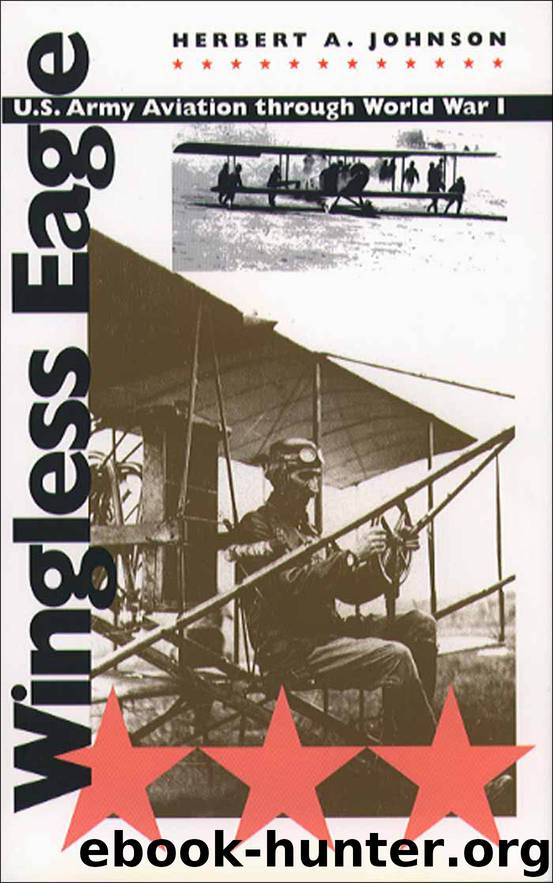Wingless Eagle by Herbert A. Johnson

Author:Herbert A. Johnson
Language: eng
Format: epub
Publisher: The University of North Carolina Press
Published: 2001-05-14T16:00:00+00:00
Doctrinal Changes in American Military Thought
The year 1915 proved to be a turning point in the evolution of military aviation doctrine, not only because of Major Squier’s observations in France, but also because the publication of the doctrinal supplement to army policy, entitled “Military Aviation.”54 Written in 1915 and printed by the Government Printing Office the following year, this statement demonstrates the degree to which army planners had accepted the lessons taught by the European war. Beginning with coast-defense considerations, “Military Aviation” pointed out that airplanes assisting coast artillery units would scout for enemy naval forces, prevent hostile reconnaissance of the coast, destroy enemy aircraft, submarines, and surface vessels, and supply fire direction for the coast artillery guns. In the maneuver of an army, each division should be equipped with a squadron of twelve airplanes, two companies (eight airplanes) for reconnaissance and artillery observation, and one company (four planes) for bomb dropping, long-distance reconnaissance, and aerial combat. This was to be “in keeping with the best practice . . . in European war.”55
“Military Aviation” then turned to consideration of the semirigid and rigid dirigibles, as well as captive balloons. The latter had been used successfully along the Franco-German battlefront to direct artillery fire, while the rigid German dirigibles of Zeppelin design were notable for their range, duration in flight, and lift capacity. “Aeroplanes appear to be unable to cope with them at night.” With perhaps a backward glance to H. G. Wells’s War in the Air, this doctrinal statement commented that “in good weather these airships have a radius of action of from 5,000 to 6,000 miles. Moreover, they are being constantly improved, and are probably capable of crossing the Atlantic Ocean.”56 This was official policy emanating from the General Staff, and not the imaginings of novelists or the empty threats of chief signal officers and others seeking adequate funding for military aviation!
Reconnaissance activities were divided into tactical reconnaissance, to be done by ground troops or observation balloons at less than 6,000 feet, and the broader view of the battlefield and its environs, available at heights above 6,000 feet. Strategic reconnaissance was designed to locate the activities of large bodies of troops, concentrations of men and matériel, and other factors bearing upon overall characteristics of the battle. Tactical intelligence was to identify small units and provide information.
The General Staff Corps’ 1915 statement in “Military Aviation” concluded that legislation was required to provide suitable airplanes for use by the army. New captive balloon units should be created, funded, and staffed, and dirigible balloons of various sizes and types should be developed and adopted for military uses.57
“Military Aviation” was a cautious statement of official military doctrine, based to a marked degree upon the history of the European war up to the time of its drafting. It mentioned “command in the air,”58 but the full consequences of aerial superiority were not fully in evidence until the epic 1916 struggles on the banks of the Somme. The policy also identified the lack of captive
Download
This site does not store any files on its server. We only index and link to content provided by other sites. Please contact the content providers to delete copyright contents if any and email us, we'll remove relevant links or contents immediately.
| Africa | Americas |
| Arctic & Antarctica | Asia |
| Australia & Oceania | Europe |
| Middle East | Russia |
| United States | World |
| Ancient Civilizations | Military |
| Historical Study & Educational Resources |
Before Topgun Days: The Making of a Jet Fighter Instructor by Dave Baranek(793)
Enemy Coast Ahead by Guy Gibson(685)
The SAS Training Manual by Chris McNab;(673)
The True Story of Catch 22 by Patricia Chapman Meder(587)
Comet! The World’s First Jet Airliner by Graham Simons(581)
Outlaws Inc. by Matt Potter(563)
Airborne by Tom Clancy(526)
The Other Side of Airfix by Authur Ward(525)
The Wright Company by Edward J. Roach(522)
Memoirs of a Stuka Pilot by Helmut Mahlke(508)
Beyond Band of Brothers by Richard D. Winters(500)
Hitler's Eagles by Chris McNab(494)
Air Warriors by Douglas Waller(463)
Boyd by Robert Coram(457)
Stormchasers by David Toomey(450)
Pegasus, The Heart of the Harrier: The History and Development of the World's First Operational Vertical Take-off and Landing Jet Engine by Andrew Dow(448)
Airborne (1997) by Clancy Tom(444)
Focke-Wulf Fw 190 by CHRIS GOSS(424)
I Always Wanted to Fly by Wolfgang W. E. Samuel(409)
